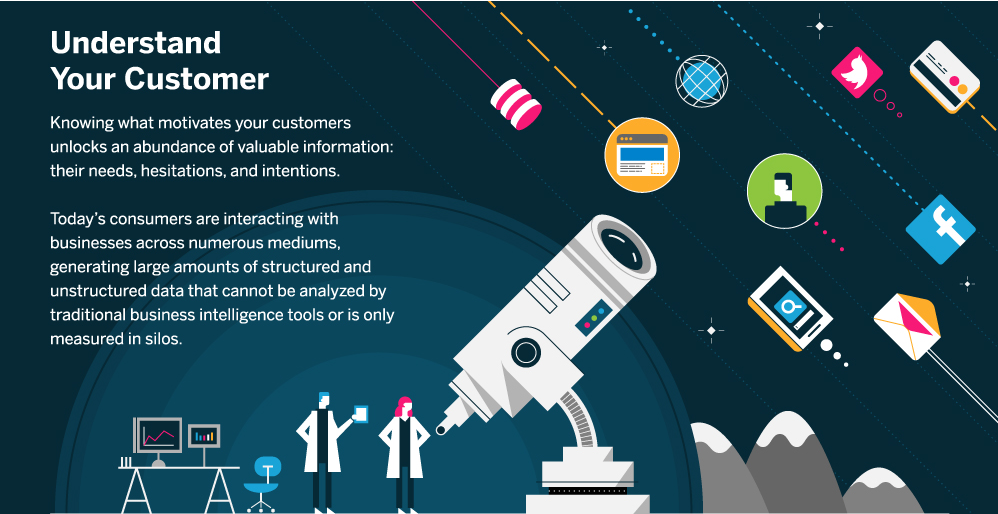How Small Businesses Should Be Using Big Data
By: Wagepoint

Think big data is only for big business? Think again. No matter how small your operation might be, collecting and analyzing data about current and future customers can produce a significant return on investment.
And the world’s businesses know this, which is why Microsoft’s Satya Nadella predicts Big Data could become a $1.6 trillion industry in the coming years.
How can your small business get in on that kind of action? Let’s take a look.
First — What Is Big Data?
According to the Data for Breakfast blog post, How to Explain Big Data to a 12-Year-Old, “Big data is simply a plethora of data, generated rapidly and from various sources.”
What Can You Do With It?
Discover Key Customer Characteristics
Don’t let the phrase “big data” fool you—you don’t have to preside over a globe-spanning operation to leverage this new tool. Even small businesses can benefit from learning about their customer base, even if it’s smaller or more regional than more recognized international brands tend to be.
One of the first—and perhaps one of the most important—ways you can begin leveraging data collection is by narrowing down your focus to only the key characteristics you wish to study. You either know, or suspect, that your most loyal customers have key traits in common with one another, and big data is the tool you need for discovering what they are.
Step one: Design a survey that will help you find out just who you’re really marketing to. People generally have no trouble finding a reason to talk about themselves, but it also couldn’t hurt to incentivize them for participating by providing incentives like discount codes. The point is to ask specific and relevant questions so you can find out who these people are, and how you can better serve them.
Your questionnaire can cover the basics, like age, race and gender, then move on to questions about habits, such as what time of the day or week they’re likely to go shopping, how they stay informed about developments in your industry and even tangentially related topics, like which websites they visit most often. But don’t overdo it—keep your questionnaire to approximately six questions. This can help you remain focused on the essentials, and won’t squander your customers’ patience or goodwill.
Surveys can be distributed via social media, email blasts and newsletter, or they can be integrated on your website. The best method of distribution varies for every company and every scenario. Use your existing data to find out where your customers are and use the tools at your disposal to develop and distribute your survey. Supplement the results with existing data to get a bigger picture.
Look at the Bigger Picture
The above suggestion provides a bit of a personal touch, but it also requires that you have an existing sample set—a customer base—to draw from. What if you’re just beginning? What if you’ve got a killer idea for a product, app, service or website, but you’d like to know how it might fit into the bigger picture, and how you might go about marketing it?
Big data comes through for you there, as well. There’s a host of analytical tools at your disposal that can help you pour through accumulated data on shopping trends, web search habits, competitor pricing and a whole lot more.
Consider for a moment what the previous generation of marketing looked like. You suspected that certain folks would read a particular magazine or newspaper, or drive past a particular stretch of road. Then, you took out an ad or plastered your brand across a well-placed billboard. It’s the marketing equivalent of flypaper. But now, we’ve got a better way—and it’s all down to big data.
An example: If you want to know what folks are searching the internet for in a particular geographic location, Google has made it possible to perform in-depth keyword research like never before. This is nothing short of a watershed moment for small business—because with intelligence of this kind, we’re now empowered to learn about ongoing changes in demand and positive or negative market conditions, sometimes in near-real-time.
In other words, it’s never been easier to get a glimpse into the larger world of consumer habits and come away with a clear game plan for how you can tailor your products—or even introduce new ones.
Create a More Personalized Experience
In years past, retaining customers was a bit of a crapshoot. Getting them in the door—either the physical or the digital door, that is—was, well, maybe not easy, but at least straightforward. But from there, whether or not they remained a loyal customer involved a heck of a lot of guesswork. Not so these days.
In brick-and-mortar retail and e-commerce alike, the customer experience has finally reached the point where it makes or breaks a business. The one-size-fits-all approach is long behind us, swept aside in favor or a much more targeted and tailored approach.
If you’ve shopped at Sam’s Club recently, you’ve quite likely received personalized coupons and offers, in some cases generated right there at the point of sale, based on the items you buy most frequently. That’s big data at work.
But it’s also only the beginning. Creating a more bespoke experience for your customers can take many forms, based on the data you’ve gathered. This can include targeted email messages sent when customers are likely to be browsing (or when they’ve left their shopping cart abandoned), or sending out alerts to customers you haven’t seen in a while to let them know you’ve got something in the pipeline that might interest them. This is all thanks to modern data mining techniques, which can substantially improve the customer experience.
Examples: Consider KeySmart — a small company that had a very auspicious debut on Kickstarter a couple years ago. Thanks to a successful targeted email campaign, they sold out of preorders for a new product (“KeySmart Rugged”), sight unseen, almost immediately. This included existing customers as well as those who had yet to even make a purchase.
Another example is Anker, maker of mobile phone and computer accessories. They’ve got a campaign underway as we speak, targeting previous customers with tantalizing glimpses of a new product in the pipeline. Customers, chosen based on the items they’ve purchased in the past, are sent emails about the new offering — asking for direct action in the form of an email address input (even if they’re already on the company’s mailing list) to provide a concrete indication of who’s seriously interested and who’s not.
Big data is even personalizing the education experience in both public and for-profit schools, by identifying potential at-risk students and helping to develop new support systems for school district leaders, from superintendents all the way down to the instructors in the classroom.
Prevent Waste, Loss and Fraud
Major corporations are no stranger to big data. E-commerce giant Amazon.com has been leveraging data collection for years in their distribution centers to monitor employee performance, track the coming and going of products and oversee a complex operation with dozens or even hundreds of moving parts.
If the thought of tracking employees through their daily ministrations sounds intrusive, don’t worry—if you’ve ever been on the ground floor of an Amazon warehouse, you know the majority of these systems work quietly in the background and generally only make a fuss when something goes seriously wrong.
The point is that gathering data about routine daily functions can be a huge help in terms of ironing out the kinks, identifying bottlenecks and reducing duplicated or wasted efforts (before they become a bigger problem).
Another way big data can help prevent loss is the realm of fraud. For example, it’s estimated that 10% of all payments made by insurance companies are based on fraudulent claims. This is hardly a new problem. But the stakes only get higher and higher, with the potential costs now rising into the billions or even trillions of dollars on an annual basis. In the insurance industry, big data helps develop predictive models based on the reams of data available, including demographics, wages, call center records and even the weather.
These might sound like big problems for big businesses, but even small organizations can benefit from the sort of prediction models described here. Even something as “routine” as mapping costs vs. benefits, or leveraging your revenue data from over the years, can help you shift from seat-of-your-pants prognosticating to a more logical, deliberate and empirical decision-making process.
Leverage Social Media
Finally, it’s worth our time to dig into social media a bit, since it’s really become a force to be reckoned with. In the e-commerce space, 85% of online orders originate from Facebook. And if that’s not enough, consider that orders coming from Reddit increased by 152% in 2013. If that’s not reason enough to get serious about social media, we don’t know what is. And big data can help.
Recently, it’s been reported that people spend nearly an hour on Facebook each day. If you think about it, people around the world invest a lot of time each week updating their statuses and commenting on photos—and perhaps most importantly, liking and otherwise engaging with brands that pique their interest. This generates a heck of a lot of data that’s extraordinarily easy to comb through for trends and patterns.
You can, for example, dig into online tools like Moz and Ahrefs to see whether, and to what extent, your online presence on sites like Facebook, Pinterest and Reddit are generating traffic to your official website and ultimately resulting in conversions. You’ll also be able to see which types of posts, pins, tweets and yodels are leading to the best buzz, then act on it accordingly.
In other words, social media is hardly a shot in the dark—it’s an arrow—and with the right tools, you can guide it precisely where you want it.
Your Data Is Out There
According to computing giant IBM, the world generates a staggering 2.5 quintillion bytes of data each day. Even more remarkably, 90% of the world’s accumulated data was created in only the last two years. That’s not just explosive growth — it’s astronomical. We’re clearly data-obsessed as a species—but all of that information means less than nothing if we’re not putting it to work for us.
But as a small business owner, you’re obviously not dealing with quintillions of bytes of data. There’s good news, though—even if you’ve been in business for just a year, you probably have plenty of data available, just waiting to be utilized.
We’d like to give a big shout out to Sarah Landrum from Punched Clocks for this expert guest post. Got a thought, suggestion or limerick that you’d like to share? If it’s related to big data, please comment below.
 Marketing specialist and the founder of the career and lifestyle advice blog Punched Clocks (www.punchedclocks.com), Sarah Landrum is a business and career expert with a passion for writing. Between posts, Sarah spends her time chasing her dogs through the yard and DIYing her home.
Marketing specialist and the founder of the career and lifestyle advice blog Punched Clocks (www.punchedclocks.com), Sarah Landrum is a business and career expert with a passion for writing. Between posts, Sarah spends her time chasing her dogs through the yard and DIYing her home.












